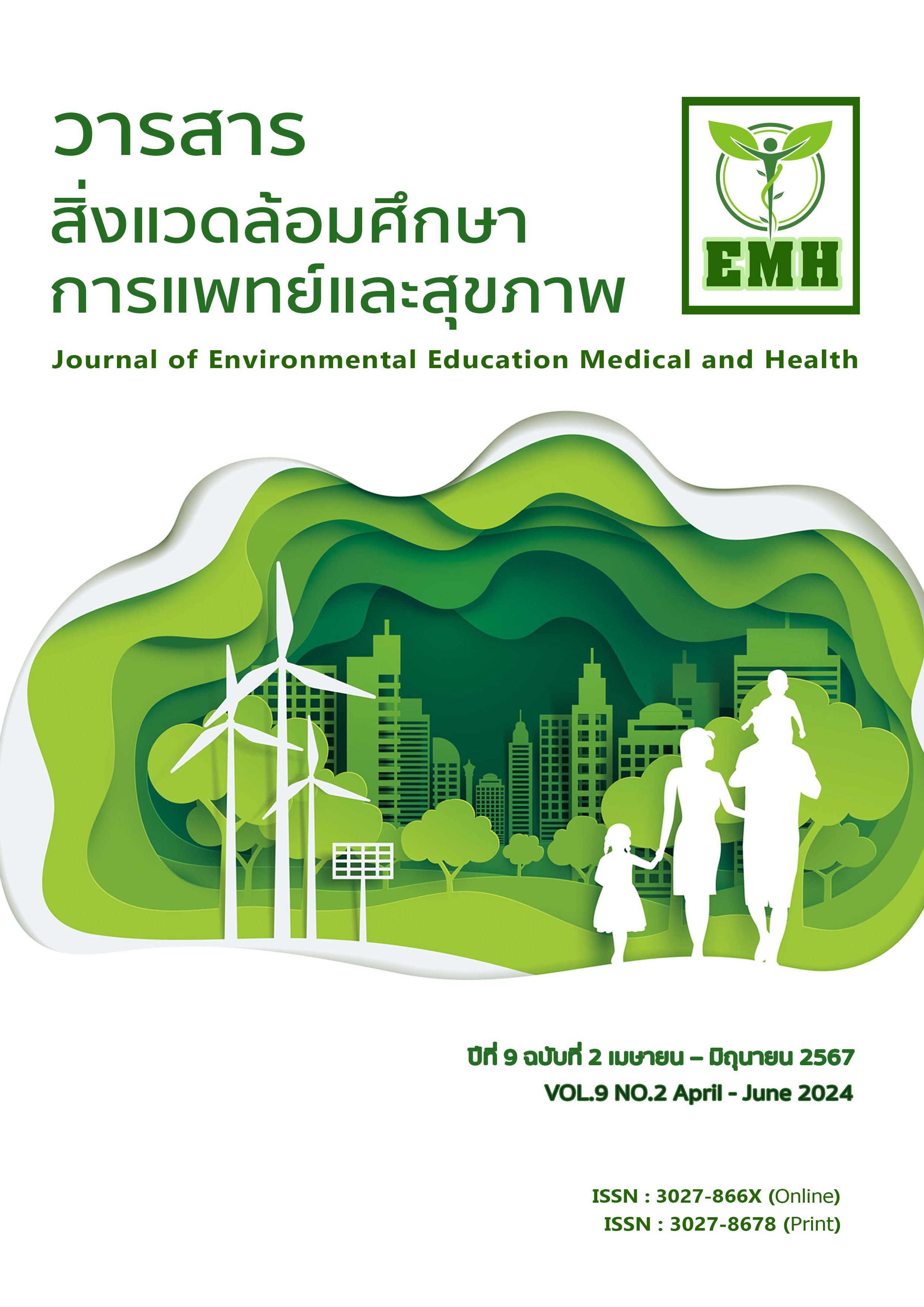การพัฒนาแนวทางการเฝ้าระวังการแพ้ยาและอาการไม่พึงประสงค์จากยา โรงพยาบาลหาดสำราญเฉลิมพระเกียรติ 80 พรรษา อำเภอหาดสำราญ จังหวัดตรัง
คำสำคัญ:
การแพ้ยา, อาการไม่พึงประสงค์จากยา, การเฝ้าระวังยาบทคัดย่อ
การวิจัยนี้มีวัตถุประสงค์เพื่อพัฒนาแนวทางการเฝ้าระวังการแพ้ยาและอาการไม่พึงประสงค์จากยาที่โรงพยาบาลหาดสำราญเฉลิมพระเกียรติ 80 พรรษา จังหวัดตรัง เป็นการศึกษาเชิงสำรวจแบบย้อนหลังโดยใช้กระบวนการถอดบทเรียน ใช้ทั้งวิธีการศึกษาเชิงปริมาณและเชิงคุณภาพ ระหว่างวันที่ 1 มกราคม 2567 ถึง 31 มีนาคม 2567 กลุ่มตัวอย่างเชิงปริมาณประกอบด้วยผู้ป่วย 140 คนที่มีประวัติการแพ้ยาและอาการไม่พึงประสงค์จากยา ระหว่างวันที่ 1 ตุลาคม 2565 ถึง 30 กันยายน 2566 และเก็บข้อมูลเชิงคุณภาพจากบุคลากรทางการแพทย์และผู้ป่วยจำนวน 20 คน โดยใช้การเลือกตัวอย่างแบบเจาะจง เครื่องมือที่ใช้ในการเก็บรวบรวมข้อมูล ได้แก่ ฐานข้อมูลเวชระเบียนของโรงพยาบาล แบบสอบถาม แบบสัมภาษณ์กึ่งโครงสร้าง และบันทึกการสังเกต วิเคราะห์ข้อมูลโดยใช้สถิติเชิงพรรณนาและการวิเคราะห์เนื้อหา
ผลการวิจัยพบว่าแนวทางที่พัฒนาขึ้นชื่อว่า "Drug Allergy Management and Monitoring System" (DAMMS MODEL) เป็นระบบการเฝ้าระวังและจัดการการแพ้ยาแบบครบวงจรที่ครอบคลุมตั้งแต่การตรวจจับ การประเมิน การเฝ้าระวัง การจัดการ และความปลอดภัย หลังการนำไปใช้ สัดส่วนของการตรวจพบผู้ป่วยแพ้ยาเพิ่มขึ้นจาก 18.56% เป็น 31.43% ขณะที่สัดส่วนของผู้ป่วยที่พบอาการไม่พึงประสงค์จากยาลดลงจาก 81.44% เป็น 68.57% ระบบนี้ช่วยให้การบันทึกและรายงานข้อมูลมีความสมบูรณ์และป้องกันการเกิดอาการแพ้ซ้ำ
เอกสารอ้างอิง
สำนักงานคณะกรรมการอาหารและยา กระทรวงสาธารณสุข. นโยบายแห่งชาติด้านยาและยุทธศาสตร์การพัฒนาระบบยาแห่งชาติ พ.ศ. 2563-2565 [อินเทอร์เน็ต]. นนทบุรี: สำนักงานคณะกรรมการอาหารและยา; 2563 [เข้าถึงเมื่อวันที่ 4 เมษายน 2566]. เข้าถึงได้จาก: https://ndp.fda.moph.go.th/ndi/policy-ndi-detail-1.
Davies EC, Green CF, Mottram DR, Pirmohamed M. Adverse drug reactions in hospital in-patients: a prospective analysis of 3695 patient-episodes. PloS one. 2021;16(7):e0254707.
Fischer F, Lange K, Klose K, Greiner W, Kraemer A. Barriers and strategies in guideline implementation—a scoping review. Healthcare. 2021;6(3):1-25.
Hickson RP, et al. Medication use in older adults with and without a drug-related inpatient encounter. Journal of the American Geriatrics Society. 2001;49(8):1071-1076.
Kaufman G. Adverse drug reactions: a review of practical considerations. British Journal of Nursing. 2015;24(10):529-536.
Kongkaew C, Noyce PR, Ashcroft DM. Hospital admissions associated with adverse drug reactions: a systematic review of prospective observational studies. The Annals of Pharmacotherapy. 2008;42(7):1017-1025.
Lee F, Chan H, Wong H. Effectiveness of drug allergy card to prevent repeated prescribing of allergenic medications in a Malaysian public hospital. Pharmacoepidemiol Drug Saf. 2019; 28:760-1. https://doi.org/10.1002/pds.4780
Quiralte J, et al. Hipersensibilidad a antiinflamatorios no esteroideos. Allergologia et Immunopathologia. 2004;32(5):233-242.
Naranjo CA, Busto U, Sellers EM, Sandor P, Ruiz I, Roberts EA, et al. A method for estimating the probability of adverse drug reactions. Clin Pharmacol Ther. 1981;30(2):239-45.
Benjamin D. Reducing Medication Errors and Increasing Patient Safety: Case Studies in Clinical Pharmacology. The Journal of Clinical Pharmacology. 2003;43. Available from: https://doi.org/10.1177/0091270003254794.
Sung T, Hung F, Chiu H. Implementation of an integrated drug information system for inpatients to reduce medication errors in the administrating stage. 2008 30th Annual International Conference of the IEEE Engineering in Medicine and Biology Society. 2008:743-746. Available from: https://doi.org/10.1109/IEMBS.2008.4649259.
ธนัฎชา สองเมือง, อนัญญา สองเมือง. โปรแกรมคอมพิวเตอร์บันทึกแจ้งเตือนรายการยาที่ผู้ป่วยมีประวัติอาการไม่พึงประสงค์ในงานบริการเภสัชกรรม. วารสารวิชาการสาธารณสุข. 2564;30(4):734-42.
Sakunrag I. การพัฒนาระบบคอมพิวเตอร์เพื่อแจ้งเตือนการแพ้ยาร่วมกับการจัดการฐานข้อมูลการแพ้ยาของโรงพยาบาลแห่งหนึ่งในจังหวัดสมุทรสาคร [อินเทอร์เน็ต]. ResearchGate; 2019 [เข้าถึงเมื่อวันที่ cite date]. เข้าถึงได้จาก: https://www.researchgate.net/publication/332554088
Rodríguez-Monguió R, Otero MJ, Rovira J. Assessing the economic impact of adverse drug reactions. Pharmacoeconomics. 2003;21(9):623-50.
Lipworth BJ. Pharmacokinetics of inhaled drugs. British Journal of Clinical Pharmacology. 2011;71(3):379-399.
Rodríguez-Monguió R, et al. Assessing the economic impact of adverse drug reactions. Pharmacoeconomics. 2003;21(9):623-650.
Shrestha R, Khan G, Thapa P, Koju R. Study of the side effects profile of different antihypertensive drugs among the hypertensive patient. Nepalese Heart J. 2013;9:25-9. https://doi.org/10.3126/NJH.V9I1.8344
Doña I, Blanca-López N, Torres MJ, García-Campos J, García-Núñez I, Gómez F, et al. Drug hypersensitivity reactions: response patterns, drug involved, and temporal variations in a large series of patients. J Investig Allergol Clin Immunol. 2012;22(5):363-71.
Pokladnikova J, Meyboom R, Meincke R, Niedrig D, Russmann S. Allergy-like immediate reactions with herbal medicines: a retrospective study using data from VigiBase®. Drug Saf. 2016;39(5):455-64.
Shehab N, Lovegrove MC, Geller AI, Rose KO, Weidle NJ, Budnitz DS. US emergency department visits for outpatient adverse drug events, 2013-2014. Jama. 2019;322(20):2018-2028.





